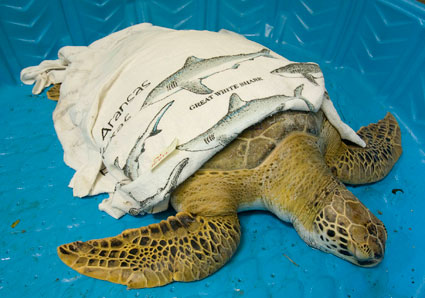
AUSTIN, Texas — An early and intensive response by state game wardens and coastal fisheries biologists, aided by United States Fish and Wildlife Service (USFWS) and National Park Service (NPS) biologists and a network of volunteers is bolstering efforts to rescue record numbers of Atlantic green sea turtles stunned during recent cold weather along the Texas coast.
Braving biting winds and air temperatures in the 30s, TPWD staff, federal agency personnel and volunteers began responding on Saturday, Jan. 9 to reports of dead and dying sea turtles from East Matagorda Bay to the Lower Laguna Madre. A sudden temperature drop of 10 degrees can cause sea turtles to go into a hypothermic state, according to biologists. Over the weekend, game wardens and coastal fisheries staff patrolling the bays and beaches helped recover dozens of stunned sea turtles ranging from 5 to 200 pounds each.
TPWD biologists and game wardens, Padre Island National Seashore and USFWS staff helped transport many of the turtles to facilities in the Corpus Christi area. The team used trucks and SUVs to move turtles wrapped in blankets to rehab facilities.
Since their rescue, the turtles are being cared for and fed in warmer indoor tanks and aquarium facilities. TPWD officials believe the rapid response allowed for speedy recovery for about 50 turtles that have already been returned to the wild.
All released turtles were tagged with passive tagging devices. In the front left flipper of each is a metal “monel” tag and a PIT (Passive Integrated Transponder). The PIT tag is a small microchip. A second metal monel tag was also placed on the rear flipper of each sea turtle.
As of Wednesday, Jan. 13, turtle sightings and recovery efforts were ongoing. Officials estimate roughly 400 green sea turtles have been affected so far, surpassing a record event in 2007 centered near Port Isabel, Texas, where 175 turtles were picked up, including 56 which died. Of this week’s total number of turtles recovered, roughly one-third were transported to rehabilitation facilities.
“The fact that so many young green sea turtles are being impacted is an indication that the population is on the rise and our healthy Texas bays offer prime nursing areas,” said Mike Ray, TPWD Acting Coastal Fisheries Division Director. “Although their numbers are declining in some parts of the world, we’re seeing more nesting activity in Mexico and green sea turtle numbers appear to be growing and expanding in Texas.”
All five species of sea turtles occurring in U.S. waters, including the Atlantic green sea turtle, are protected under the Endangered Species Act. Green turtles are the largest of all the hard-shelled sea turtles, but have a comparatively small head. While hatchlings are just 2 inches long, adults can grow to more than 3 feet long and weigh 300-350 pounds.
Officials cite a voluntary three-day suspension of barge traffic by the Gulf Intracoastal Canal Association along the Intracoastal Waterway during the freeze as having helped minimize any additional impacts to turtle populations.
While sea turtles appear to have been most impacted by the latest freeze, biologists are assessing isolated reports of fish kills across the Texas coast.
Small numbers of dead spotted seatrout have been discovered in the San Antonio Bay area, and gray snapper were affected in the Lower Laguna Madre. Other fish species have also been affected to a lesser degree. As water temperatures warm up, any dead fish may begin to float to the surface.
— SOURCE Texas Parks and Wildlife Department

